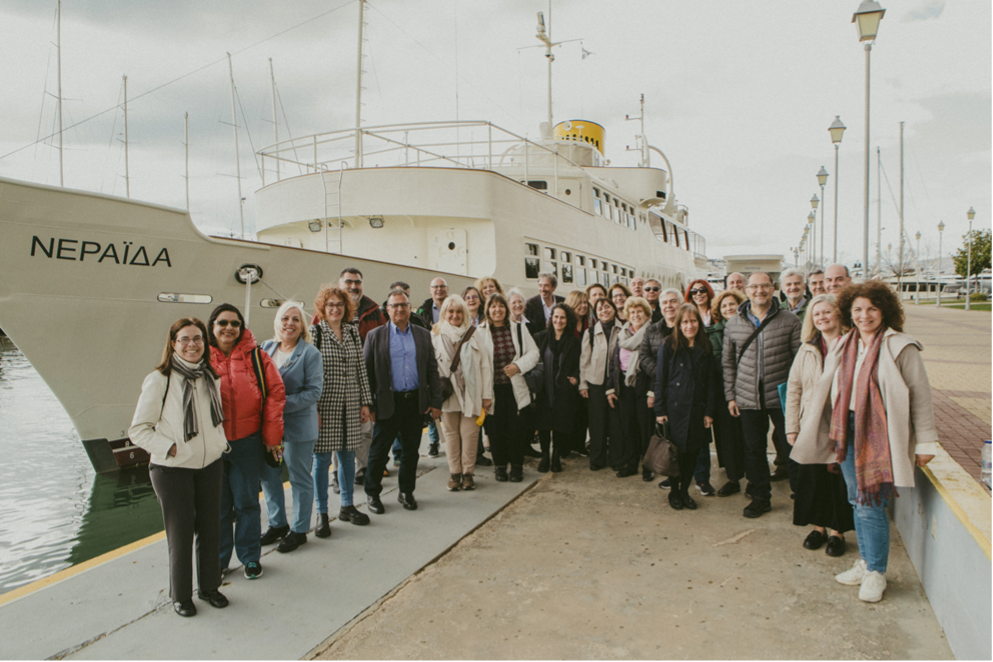This month, we talk with Christine Kourkoumelis, IPPOG representative for Greece and Emeritus Professor of Experimental High Energy Physics at the National and Kapodistrian University of Athens. Christine has been involved in scientific outreach for decades, contributing to tools like HYPATIA and supporting both teachers and students through EU projects and school visits.
Here’s what she shared with us:
- Can you introduce yourself and share how you became involved in the world of scientific outreach?
Ι am the Greek representative in IPPOG and an Emeritus Professor of experimental HEP at the National and Kapodistrian University of Athens (NKUA). I got involved in outreach many years ago and organized at NKUA the first edition of the International Masterclasses about 25 years ago with the LEP data, at the time. When I joined ATLAS, I was asked by the management to create an interactive event viewing tool. So that was the start of ATLAS Student Event Project (ASEP), done by myself, a student from NKUA and one from the Institute of Physics in Belgrade. It then evolved to become HY.P.A.T.I.A (Hybrid Pupil’s Analysis Tool for Interactions in ATLAS) an offline version written in Java. At the same time I tried to persuade the Masterclass responsibles as well as the outreach coordinators of the four LHC experiments to switch from using the LEP data into the LHC data (real or MC).This was accomplished in 2011 and HYPATIA (http://hypatia.phys.uoa.gr/) is used by thousands of students from all over the world to analyse the ATLAS data in the so called “Z/Higgs path”. Later the need for a more flexible version of HYPATIA to be used in laptops, phones etc -without any downloadable need- became apparent. So joined by new people we developed the online version of HYPATIA (https://hypatia.iasa.gr/) at the NKUA (in four different languages) and used it in school visits doing mini-masterclasses all over the country. With help of HYPATIA students can calculate invariant masses, apply cuts and do dedicated analysis of the ATLAS events. For these activities, I was a recipient of the 2011 EPS HEP outreach prize.
- What has been the most meaningful outreach activity you’ve organized or participated in, and why?
Since 2008 I have participated in eight EU outreach projects with the aim of building resources mainly for the high teachers. The first consortium called “Learning with ATLAS@CERN” , which I coordinated as well, had 11 partners (including CERN) for 8 different counties and built a repository of thousands of educational content. The last one was a Swafts project called REINFORCE (https://reinforceeu.eu/) which enabled citizen/scientists to have access to data from large reach infrastructures (CERN,EGO,Neutrino telescopes etc).I enjoyed very much interacting with the citizens volunteers from all over the world. On the other hand, visiting schools in small villages in Greece and getting the feedback from students with very limited access to international resources was most gratifying. I also remember the excitement of 4th July 2012, when I was ATLAS outreach co-coordinator and was in Crete participating in a press conference at the University of Crete and then running off to a different town to break the news at a European summer school with participation of large number of Erasmus teachers.
- What inspires you the most about sharing particle physics with the public?
Sharing the information is important for many reasons. Engaging the public to learn interactively is even more profitable and enjoyable. Furthermore, I try to enhance the data accessibility for visually impaired citizens. In addition, I feel the obligation to inform the stakeholders about the accessibility of the basic research, because -after all-it is publicly funded.
- What is the most important message you would like to convey to younger generations through your outreach efforts?
I am pleased meeting freshman physics students at the university who confess that they have chosen the subject because of their participation in a Masterclasses at high-school. Of course, not everybody wishes to become a scientist but sharing the state-of-the -art research and the cutting edge technologies, the excitement of scientific exploitation and discoveries, inspires the young minds and introduces them to the appropriate methodology on many fronts. Then, they should be free and “follow their hearts”.

Christine’s work shows how research, education, and public engagement can come together to make science more accessible. Her story is a reminder of how much impact dedicated outreach can have, especially in inspiring the next generation.


